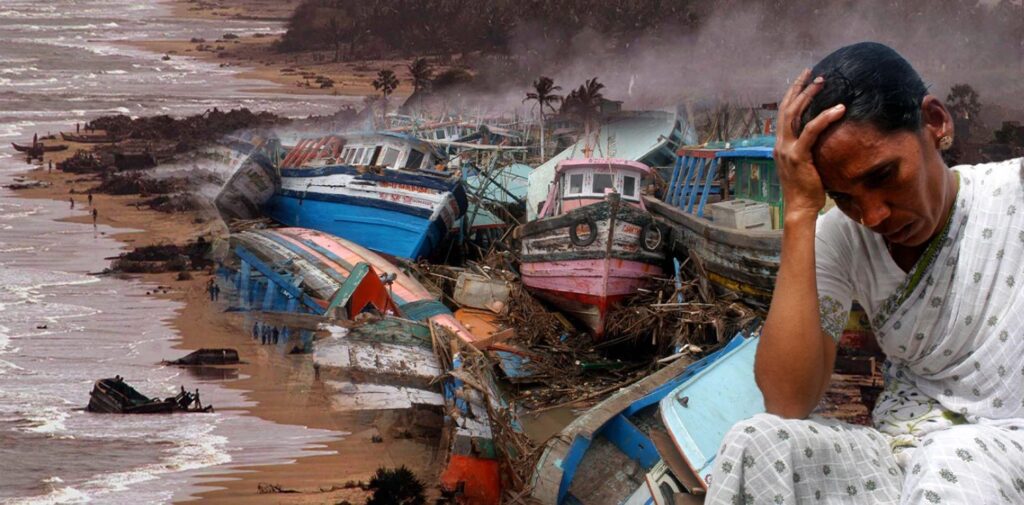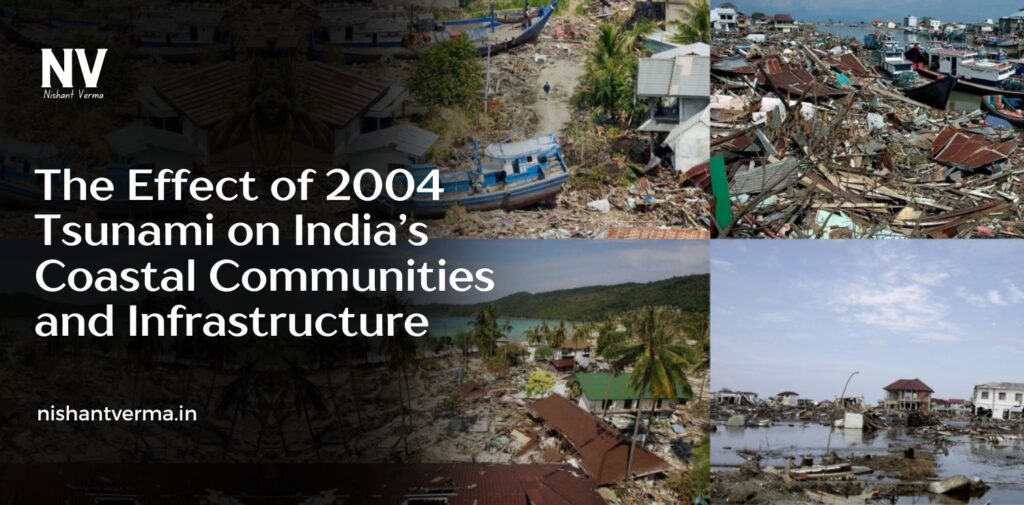On December 26, 2004, one of the deadliest natural disasters in recent history struck the Indian Ocean, causing widespread devastation across several countries, including India. A massive undersea earthquake off the coast of Sumatra, Indonesia, triggered a series of tsunamis that affected the coastal regions of India, particularly in Tamil Nadu, Andhra Pradesh, Kerala, and the Andaman and Nicobar Islands. The 2004 tsunami left behind a trail of destruction, claiming thousands of lives and causing massive damage to the affected areas’ infrastructure. This article explores The Effect of 2004 Tsunami on India’s coastal communities and infrastructure and highlights the recovery efforts that followed.
1. The Tsunami Strikes: A Sudden and Unexpected Disaster
The 2004 tsunami was triggered by an undersea earthquake with a magnitude of 9.1-9.3, which struck off the coast of Sumatra, Indonesia. The earthquake caused the sea floor to shift, displacing enormous amounts of water and sending waves as high as 30 meters toward the Indian Ocean’s coastal regions. These waves travelled at incredible speeds, and the coastal communities, particularly in Tamil Nadu, Andhra Pradesh, and the Andaman and Nicobar Islands, had little warning of the impending disaster.
A. Immediate Impact
The tsunami reached the Indian coastline within hours, with waves hitting the shore early in the morning. Coastal communities along the southeastern coast, especially in Tamil Nadu, Andhra Pradesh, and Kerala, were caught off guard. The suddenness of the disaster made it even more catastrophic. Villages were swept away, and the lives of thousands of people were affected in a matter of minutes. Buildings, boats, crops, and roads were destroyed, while thousands of families lost their homes and livelihoods.
B. Loss of Life
The human cost of the disaster was staggering. Over 10,000 people lost their lives in India, and many more were injured or left homeless. The coastal regions of Tamil Nadu were the worst hit, particularly areas like Nagapattinam, Cuddalore, and Kanyakumari. The Andaman and Nicobar Islands also saw significant loss of life, as well as severe damage to infrastructure. The impact of the tsunami was not only felt by local communities but also by tourists who were vacationing in the affected areas.

2. Destruction of Infrastructure: A Devastating Blow
In addition to the tragic loss of life, the tsunami also caused widespread damage to India’s coastal infrastructure, including roads, bridges, ports, schools, and hospitals. Many key infrastructure elements were either damaged or destroyed, making it difficult for relief efforts to reach the affected regions.
A. Damage to Transportation Networks
The coastal roads, which were crucial for moving people and goods, were severely damaged by the tsunami. In Tamil Nadu and Kerala, several roads were completely submerged or washed away. This created logistical challenges for rescuers and relief workers trying to access the affected areas. Moreover, the destruction of bridges and railways further delayed aid and rescue operations, making it difficult to evacuate survivors or transport emergency supplies.
B. Ports and Fishing Infrastructure
Many fishing communities along India’s coast rely heavily on their local ports and harbours for their livelihood. The tsunami destroyed several key fishing harbours, such as the ones in Tamil Nadu, leaving fishermen without access to their boats and equipment. Additionally, boats that were washed away or destroyed by the waves were crucial to these communities’ daily survival. The loss of fishing infrastructure had long-term economic consequences for these coastal communities, as fishing is an important industry for both local consumption and export.
C. Destruction of Homes and Businesses
The tsunami left tens of thousands of families without homes. Villages along the coastline were swept away, with buildings and homes destroyed. In some cases, entire communities were wiped out, with only rubble left behind. Small businesses, including shops and restaurants, were also destroyed, further exacerbating the economic impact on local communities. This widespread destruction meant that many people not only lost loved ones but also their livelihoods.

3. Displacement and Humanitarian Crisis
In the aftermath of the tsunami, India faced a massive humanitarian crisis. Thousands of people were displaced from their homes, and forced to live in temporary shelters. The lack of basic amenities such as food, water, and sanitation facilities added to the suffering of survivors.
A. Temporary Shelters and Relief Camps
In the days and weeks following the tsunami, the government and various non-governmental organizations (NGOs) set up temporary relief camps to house displaced families. These camps provided food, water, and medical care to survivors. However, the sheer scale of the disaster meant that these camps were often overcrowded and lacked sufficient facilities. The displaced people were forced to live in difficult conditions, with limited access to healthcare and basic amenities.
B. Psychological Impact on Survivors
The trauma of losing loved ones and witnessing the devastation left lasting psychological scars on the survivors. Many people in the affected regions, particularly children and the elderly faced mental health challenges such as depression, anxiety, and post-traumatic stress disorder (PTSD). The emotional toll of the tsunami was just as severe as the physical and economic impact, requiring long-term mental health support for those affected.
4. The Role of Government and NGOs in Recovery
In the face of such a large-scale disaster, the Indian government and various NGOs played a critical role in providing immediate relief and facilitating the recovery process. The government launched a massive rescue and rehabilitation effort, while NGOs and international aid organizations worked to provide essential services to the affected populations.
A. Emergency Response and Rescue Operations
The Indian government, along with the Indian Armed Forces, immediately launched emergency rescue operations. Thousands of personnel were deployed to search for survivors, provide medical care, and distribute food and water. Additionally, the government provided financial assistance to the families of those who lost their lives and helped rebuild infrastructure, including roads, schools, and hospitals.
B. Rehabilitation and Reconstruction
The recovery and rehabilitation process took years. The government, with the help of NGOs, began the long task of rebuilding the affected regions. This included the reconstruction of homes, schools, hospitals, and fishing harbours. In Tamil Nadu, Kerala, and the Andaman and Nicobar Islands, new homes were built for displaced families, and businesses were given financial support to rebuild. Efforts were also made to restore the local fishing industry by providing new boats and equipment to fishermen.
C. Long-Term Support
Beyond the immediate relief and reconstruction efforts, long-term support was necessary to help the affected communities recover fully. The government introduced programs to promote economic recovery, such as providing loans for rebuilding homes and businesses. NGOs worked on rehabilitating the mental health of survivors, providing counselling and therapy to help them cope with the trauma.

5. Lessons Learned and Preparedness for Future Disasters
The 2004 tsunami taught India several valuable lessons in disaster preparedness and response. While the immediate relief efforts were effective in saving lives, the tragedy highlighted the need for improved early warning systems and better infrastructure for handling such disasters.
A. Early Warning Systems
In response to the 2004 tsunami, India took significant steps to improve its early warning system. The Indian National Centre for Ocean Information Services (INCOIS) developed a tsunami warning system to provide timely alerts for coastal areas in case of future tsunamis. This system aims to reduce the loss of life and property by giving people enough time to evacuate.
B. Disaster Preparedness and Response Plans
The government, in collaboration with various state agencies and local authorities, has worked to improve disaster preparedness at the community level. Drills and awareness programs have been introduced to educate coastal communities about how to respond in the event of a tsunami or other natural disasters. Furthermore, the government has focused on strengthening coastal infrastructure to make it more resilient to future tsunamis.
Conclusion: The Effect of 2004 Tsunami
The 2004 tsunami left an indelible mark on India’s coastal communities, causing extensive loss of life, destruction of infrastructure, and displacement of thousands of people. The aftermath of the disaster was marked by a large-scale recovery and reconstruction effort, led by the Indian government and supported by NGOs and international organizations.
While the recovery process was slow and difficult, India’s coastal communities gradually rebuilt their lives. The lessons learned from the tsunami have also strengthened India’s disaster preparedness and response systems, ensuring that the country is better equipped to handle similar events in the future. The 2004 tsunami remains a tragic reminder of the vulnerability of coastal regions, but it also highlighted the resilience and strength of the people who survived and rebuilt their communities.




